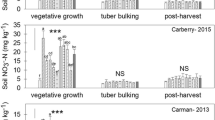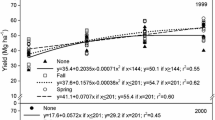Abstract
Russet Burbank and Shepody potatoes were grown with at-planting N fertilizer rates ranging from 0 to 270 kg ha−1 during 1986 through 1989. Experiments were conducted each year following small grains and red clover. Total yields and tuber size were strongly increased by N on most sites where potatoes followed small grains. Specific gravities declined with increasing N rate. Total yields of Russet Burbank and Shepody were optimized at an average of 196 and 211 kg ha−1 of N, respectively, following small grains.
The effect of N fertilizer on yields was much less dramatic following red clover. Total yields averaged 88% of maximum with only 45 kg ha−1 of N applied, compared to 77% of maximum for this N rate following small grains. Total yields for the two varieties were optimized at 126 and 136 kg ha−1, respectively. U.S. #1 yields were generally not increased at N rates above 45 to 90 kg ha−1 following red clover and tuber size was not increased at rates above 90 to 135 kg ha−1. Based on these studies, the N fertilizer credit for red clover grown prior to potatoes can be up to 75 kg ha−1. Maintenance of tuber quality necessitates conservative use of N fertilizer when potatoes are grown following legumes. The highest N rates tested suppressed total yields of Russet Burbank, a late-season, indeterminate variety, by approximately 9% averaged over cropping systems.
Compendio
Papas Russet Burbank y Shepody fueron cultivadas bajo dosis de fertilizante nitrogenado que variaban de 0 a 270 kg ha−1, a continuacion del cultivo de paqueños granos y trebol rojo. Durante las temporadas de cultivo 1986 a 1989 se tomaron muestras de peciolos del 4to. y 5to. folíolo en 4 a 6 fechas para cada una. Se secaron y analizaron las muestras para determinar su contenido en NO3 −N. Los niveles de NO3 −N en los peciolos estuvieron estrechamente relacionados a las dosis de nitrógeno independientemente del cultivar, temporada y sistema de cultivo. Las diferencias entre tratamientos y el contenido de NO3 −N variaron sustancialmente conforme avanzaba la temporada de cultivo, con niveles de NO3 −N en los peciolos declinando rápidamente en las parcelas no fertilizadas conforme las plantas envejecían.
Los niveles de NO3 −N en los peciolos fueron más altos a media temporada a continuatión de trebol rojo que a continuación de los pequeños granos.
Lo más apropiado es tomar las muestras a los 50 a 60 días después de la siembra (DDS) como un medio para programar la aplicación de nitrógeno suplementario. A los 50 DDS los niveles críticos de NNO3 −N en los peciolos fueron 1,6 y 1,7% para Russet Burbank y Shepody, respectivamente. Los niveles de NO3 −N en los peciolos, por encima de 2,2%, a los 50 DDS, correspondieron a rendimientos más bajos de Russet Burbank en comparación con los rendimientos obtenidos cuando los niveles de NO3 −N en los peciolos fueron de 1,6 a 2,2%. El muestreo de NO3 −N en los peciolos podría ser particularmente util como diagnóstico en las estrategias de manejo que hacen uso máximo de residuos de cultivos anteriores, enmiendas orgánicas y reservas del suelo, como fuentes de nitrógeno.
Similar content being viewed by others
Literature Cited
Anonymous. 1972. Soil survey laboratory methods and procedures for collecting soil samples. Soil Survey Investigations Report No. 1, USDA-SCS, Washington, D.C., 63 pp.
Boehlje, M.D. and V.P. Eidman. 1984. Farm management. John Wiley and Sons, 806 pp.
Fox, R.H. and W.P. Piekelek. 1988. Fertilizer N equivalence of alfalfa, birdsfoot trefoil, and red clover for succeeding corn crops. J Prod Agric 1:313–317.
Hawkins, A. 1946. Rate of absorption and translocation of mineral nutrients by potatoes in Aroostook County, Maine, and their relation to fertilizer practices. Agron J 38:667–681.
Hesterman, O.B., M.P. Russelle, C.C. Sheaffer and G.H. Heichel. 1987. Nitrogen utilization from fertilizer and legume residues in legume-corn rotations. Agron J 79:726–731.
Kleinkopf, G.E., D.T. Westermann and R.B. Dwelle. 1981. Dry matter production and nitrogen utilization by six potato cultivars. Agron J 73:799–802.
Kleinkopf, G.E. and D.T. Westermann. 1982. Scheduling nitrogen applications for Russet Burbank potatoes. University of Idaho, Current Information Series no. 637.
Millard, P. and B. Marshall. 1986. Growth, nitrogen uptake and partitioning within the potato (Solanum tuberosum L.) crop, in relation to nitrogen application. J Agric Sci 107:421–429.
Neeteson, J.J. 1989. Evaluation of the performance of three advisory methods for nitrogen fertilization of sugar beet and potatoes. Neth J Agric Sci 37:143–155.
Neeteson, J.J. and H.J.C. Zwetsloot. 1989. An analysis of the response of sugar beet and potatoes to fertilizer nitrogen and soil mineral nitrogen. Neth J Agric Sci 37:129–141.
Magdoff, F.R., D. Ross and J. Amadon. 1984. A soil test for nitrogen availability to corn. Soil Sci Soc Am J 48:1301–1304.
Murphy, H.J., P.N. Carpenter and M.J. Goven. 1965. Potato fertilization — rotation studies on Aroostook Farm permanent fertility plots, 1951–1965. Maine Agri Exp Sta Bull 645. 60 pp.
Porter, G.A. and J.A. Sisson. 1989. Growth and dry matter partitioning of Russet Burbank and Russette potatoes subjected to varying nitrogen fertilizer rates. Am Potato J 66:540 (abstr.).
Ris, J., K.W. Smilde and G. Wijnen. 1981. Nitrogen fertilizer recommendations for arable crops based on soil analysis. Fertilizer Research 2:21–32.
Rourke, R.V. 1985. Soil solution levels of nitrate in a potato-buckwheat rotation. Am Potato J 62:1–8.
SAS Institute. 1985. SAS user’s guide. Statistics, version 5. SAS Institute, Cary, N.C.
Terman, G.L., A. Hawkins, C.E. Cunningham and R.A. Struchtemeyer: 1951. Rate, placement, and source of nitrogen for potatoes in Maine. Maine Agri Exp Sta Bull 490. 34 pp.
Timm, H., J.C. Bishop and V.H. Schweers. 1963. Growth, yield, and quality of White Rose potatoes as affected by plant population and levels of nitrogen. Am Potato J 40:182–192.
Westermann, D.T. and G.E. Kleinkopf. 1985. Nitrogen requirement of potatoes. Agron J 77:616–621.
White, R.P., D.C. Munro and J.B. Sanderson. 1974. Nitrogen, potassium and plant spacing effects on yield, tuber size, specific gravity, and tissue N, P and K of Netted Gem potatoes. Can J Plant Sci 54:535–539.
Author information
Authors and Affiliations
Additional information
Maine Agricultural Experiment Station Publication #1499.
Rights and permissions
About this article
Cite this article
Porter, G.A., Sisson, J.A. Response of Russet Burbank and Shepody potatoes to nitrogen fertilizer in two cropping systems. American Potato Journal 68, 425–443 (1991). https://doi.org/10.1007/BF02853781
Accepted:
Issue Date:
DOI: https://doi.org/10.1007/BF02853781




